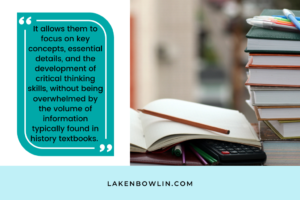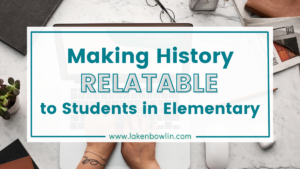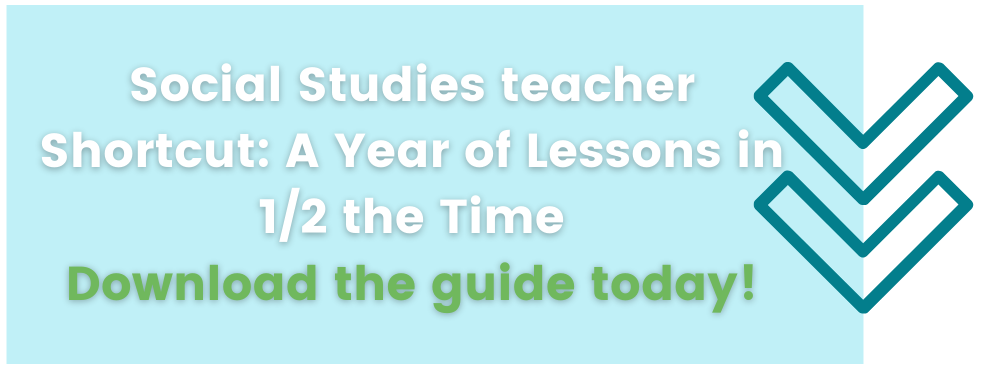 History is a fascinating subject that helps students understand the world around them and how it has evolved over time. In elementary school, it’s crucial to make history lessons engaging and accessible to young learners. One effective strategy for achieving this goal is using scaffolded notes. These guided notes provide students with structured support for understanding and retaining historical information. In this blog, we will explore the benefits of using scaffolded notes in elementary school history classrooms and provide a step-by-step guide on how to implement them effectively.
History is a fascinating subject that helps students understand the world around them and how it has evolved over time. In elementary school, it’s crucial to make history lessons engaging and accessible to young learners. One effective strategy for achieving this goal is using scaffolded notes. These guided notes provide students with structured support for understanding and retaining historical information. In this blog, we will explore the benefits of using scaffolded notes in elementary school history classrooms and provide a step-by-step guide on how to implement them effectively.
Are you looking for planning resources that are easy to use, minimal prep, and ready at your fingertips? I have created a planning document for upper-elementary social studies teachers, and you are definitely going to want to go check it out! 👀 I have pacing, linked resource ideas, and essential questions ready to go for you. If you teach in the upper elementary classroom, there is something for you in that document. What are you waiting for? Go check it out HERE!
What are Scaffolded Notes?
Scaffolded notes are a teaching tool that assists students in taking organized, purposeful notes. This method involves providing students with partially completed notes, outlines, or graphic organizers. It allows them to focus on key concepts, essential details, and the development of critical thinking skills, without being overwhelmed by the volume of information typically found in history textbooks.

Benefits of Scaffolded Notes
- Promotes Active Learning: Scaffolded notes encourage students to actively engage with the material. Instead of passively reading or listening to a lecture, students must interact with the content as they complete the notes.
- Differentiated Learning: Not all students learn at the same pace or in the same way. Scaffolded notes can be tailored to the needs of individual students or groups, making it easier to address a variety of learning styles and abilities in the classroom.
- Improved Retention: Research has shown that when students take notes, they are more likely to retain and recall the information. Scaffolded notes guide them in the note-taking process, increasing the likelihood of retaining the material.
- Enhanced Comprehension: Structured notes help students identify the main ideas, supporting details, and relationships between historical events. This promotes a deeper understanding of the subject matter.
- Organization Skills: Scaffolded notes teach students how to organize information systematically, a skill that is valuable not only in history but also in other subjects and life situations.
How to Implement Scaffolded Notes in Social Studies
- Choose Your Content: Start by selecting the historical topic you want to cover. It’s essential to break down the content into manageable sections, considering the age and grade level of your students.
- Design Scaffolded Notes: Create the scaffolded notes by organizing information in a clear and concise manner. You can use templates, graphic organizers, or outlines. Leave blanks or spaces where students should fill in key information.
- Introduce the Lesson: Begin the lesson with an engaging introduction to the topic. Explain to students why they are learning about it and what they should expect to gain from the lesson.
- Distribute Scaffolded Notes: Hand out the scaffolded notes to students. Make sure they understand the purpose and how to use them effectively. You can provide both digital and printed copies, depending on your classroom’s resources.
- Active Learning: As you present the lesson, encourage students to actively participate. Ask questions, engage in discussions, and guide them through the process of completing their scaffolded notes.
- Check for Understanding: Periodically, check in with students to ensure they are on the right track. Address any questions or concerns and provide additional explanations or examples as needed.
- Independent Work: After the lesson, have students complete the notes on their own. This allows them to reinforce what they’ve learned and practice their note-taking skills.
- Review and Discuss: Once the notes are completed, review them as a class. Discuss the main ideas, details, and connections. This is also a good time for students to ask any remaining questions.
- Assessment: Use the notes as a basis for assessments, such as quizzes or projects. This helps evaluate students’ understanding of the material.
 Scaffolded notes can be a powerful tool for making history classes in elementary school more engaging and accessible. By providing structured support and encouraging active learning, teachers can help their students develop strong note-taking skills, a deeper understanding of history, and a lifelong love of learning. So, why wait? Start implementing this in your elementary school history classroom today and watch your students’ historical knowledge and enthusiasm grow.
Scaffolded notes can be a powerful tool for making history classes in elementary school more engaging and accessible. By providing structured support and encouraging active learning, teachers can help their students develop strong note-taking skills, a deeper understanding of history, and a lifelong love of learning. So, why wait? Start implementing this in your elementary school history classroom today and watch your students’ historical knowledge and enthusiasm grow.
Did you miss it? It’s okay, I got you! I know you are overwhelmed with planning engaging lessons across all your subjects, so don’t make social studies become another pain point for you. Download your Social Studies Teacher Shortcut: A Year of Lessons in ½ the Time to get all your planning organized and in one place.

Related Articles
Websites for Career Research: 5 Sites for Empowering Students
Engaging Back to School Activities for Social Studies
How to Use PowerPoint in the Classroom to Step Up Your PowerPoint Lessons








